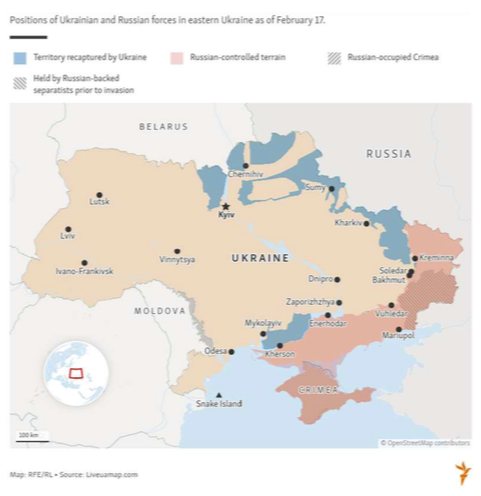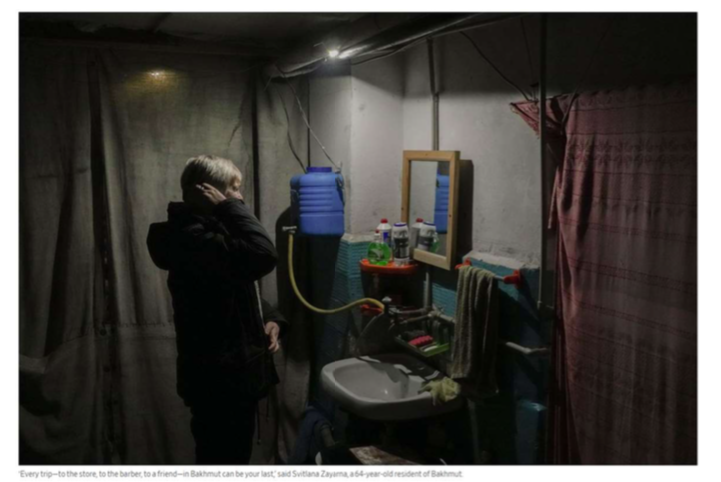This Friday, the 24th of February, marks the one-year anniversary of the start of the largest land war in Europe since World War II. We wrote two notes about the situation in 2022, one before the invasion and one immediately afterward. However, the conflict has only intensified since that time and this “unfortunate anniversary” provides an opportunity to both assess where things stand today and to explore potential paths forward.

Where do things stand currently?
First and foremost, we think it is important to recognize the immense humanitarian impact that has resulted from this war. While reliable reports on casualties are hard to come by, Chairman of the US Joint Chiefs of Staff, General Mark Milley, estimated in November 2022 that Russia and Ukraine had each suffered approximately 100,000 casualties and that another 40,000 Ukrainian civilians had been killed since the invasion began.
In addition, he estimated that the war had created between 15 and 30 million refugees.1 More recent estimates from early February up the Russian figures, citing approximately 180,000 Russian casualties since the outbreak of the war.2 Regardless of the exact number of casualties, the war has resulted in an enormous amount of human suffering. In addition, the constant shelling, up to 30,000 shells fired back and forth each day, has laid waste to many cities, towns, and much of Ukraine’s infrastructure.3
Turning our attention to where things stand with the battle lines a year into the war, in short, the two sides are at a stalemate. Russia’s initial push into Ukraine at the onset of the war was halted by the Ukrainians last year and in some cases, Ukraine has fought back to reclaim territory as the war has continued (see blue areas of the map at left). If Russian President Vladimir Putin assumed he could quickly overwhelm Ukraine and exploit fault lines in NATO a year ago, he is surely aware of his miscalculation today.

When asked in a recent interview whether NATO is obsolete, David Petraeus, retired US General and former Director of the CIA, answered as follows:
“This question gets at one of the ironies of the situation. Putin set out to ‘Make Russia Great Again.’ However, what he has done is make NATO great again – with two very capable, historically neutral powers (Finland and Sweden) seeking NATO membership; with substantially increased defense spending by NATO members, most notably Germany; with augmentation of NATO forces in the Baltic states and eastern Europe; and with the greatest unity among NATO members since the end of the Cold War.”4
Who has the advantage currently?
The front lines have largely hardened in recent months, making territorial gains more difficult to come by, and it is natural to wonder what could tip the balance of power in favor of one side or the other. Russia’s most obvious advantage is straightforward enough, sheer numbers. In the past few days, they have launched a new offensive with the goal of overwhelming Ukrainian soldiers to regain territory after months of setbacks.
“The reality is we have seen the start [of a Russian offensive] already because we see now what Russia does now — President Putin does now — is to send thousands and thousands more troops, accepting a very high rate of casualty” – NATO Secretary General Stoltenberg5
Putin may also believe that Russia is better positioned to come out on top in a protracted conflict for another reason – perseverance. The West has already thrown the equivalent of the kitchen sink at Russia in the form of economic sanctions, but ties with China, Iran, and India appear to be strong enough for their economy and military complex to keep afloat. He may believe that the longer the war draws out, the more likely that Ukraine will lose the US and Western ally support it needs to survive. In short, Putin may be betting his country can out- suffer everyone, as concerns over the war’s cost and the fear of escalation with a nuclear-armed Russia will make it politically unsustainable for the coalition of democracies that comprise its opposition to continue.6
However, Ukrainians can argue that if the past year has proven anything, it is that this underdog is more than capable of pushing the Russian aggressors out of their country. By most accounts, they have outperformed all expectations thus far (while Russia has proven to be less capable than anticipated) with far fewer resources than their adversary when the war began. Ukraine continues to get improving weaponry and training from the West and they’ve proven adept at learning and adapting to new technology quickly.

Additionally, Ukrainian President Zelensky has been successful at both raising needed military support from the West and rallying the morale of his country in the face of incredible adversity (see image at right of a woman in Bakhmut trying to survive in the warzone7). The ability to withstand suffering has long been part of Russia’s national mythos, however, Ukrainians are proving in this war that Russians do not have a monopoly on tenacity.
When asked later in the interview about the role of morale in war, General Petraeus responded as follows,
“That is a huge factor. Ukrainians see the ongoing conflict as their War of Independence, and they have responded accordingly. President Volodymyr Zelensky has been positively Churchillian in rallying all Ukrainians to the service of their country as it fights for its national survival.”
When contrasted with the exodus of Russian men last fall when Putin announced mobilization, it is easy to understand why President Zelensky believes Ukraine will ultimately prevail.8
What impact has the war had on global markets?

Global stocks and bonds (as measured by the MSCI ACWI and Bloomberg Global Aggregate Bond indexes, at right) are both lower today than they were when the Russian invasion of Ukraine occurred in February of last year (invasion date marked by the arrow). However, much of the volatility of the past year has been driven by inflation and the need for global central banks to raise rates to combat rising costs. As a result, it is difficult to know what impact the war would have had absent the inflationary environment.
What is much clearer is how the war has impacted Russian equities (see iShares MSCI Russia ETF in red, above). The restrictions placed on Russian securities after the invasion means that most international investors have been unable to trade them and prices subsequently plummeted. In addition to the military setbacks Russia has faced in Ukraine, becoming a “pariah state” has inflicted economic and market- related costs on the country, as well. In this way, the invasion of Ukraine may serve as a cautionary tale for other countries contemplating unprovoked military aggression.
How does this end?
Ideally, this ends with a negotiated resolution soon and without the conflict expanding beyond Ukrainian borders. The war has been devastating for both countries, albeit in different ways. We will be watching to see if the narrative on either side begins to shift, as both sides will want to assure their citizens that their country “won” before bringing the war to a peaceful resolution. This would be the best outcome from both a humanitarian and market perspective.
Unfortunately, a much worse possibility also exists, that this conflict draws other countries into conflict. The most obvious way this could occur would be for a perceived “red line” to be crossed, such as Russia attacking another NATO country or using tactical nuclear weapons, or the West providing weaponry enabling Ukraine to take the offensive and strike within Russia. Although the US and Germany have agreed to supply tanks, Ukrainian requests for fighter jets such as the US F-16 have not been fulfilled at this time, indicating that the West is exercising caution at the moment.
A less obvious path to escalation also exists – Ukraine becomes the ideological wedge that further divides the world into two opposing sides, the West and the “anti-West”. Unfortunately, some early signs indicate that this may be happening to some extent, as China, Iran, and North Korea appear to be aligning themselves with Russia on the anti-West side. Hopefully the tensions of the present moment abate, diplomacy again takes center stage and ensures that a regional conflict does not escalate into something far worse.
As always, navigating investment markets involves striking a balance between potential risks and rewards. A geopolitical event of the magnitude of the war in Ukraine certainly brings with it a significant amount of uncertainty and risk. However, we remain hopeful that the two sides will seek out an off-ramp to this conflict before another anniversary comes around. Regardless, we will be monitoring the situation closely on your behalf. Please reach out if you would like to schedule a time to review your specific situation.
1 Source: Ukraine war: US estimates 200,000 military casualties on all sides – BBC New
2 Source: Russia’s Casualties in Ukraine Near 200,000 – WSJ
3 Source: When Will War in Ukraine End? Ammo Shortage Risks Prolonged Conflict – Bloomberg
4 Source: Gen. David Petraeus: How the war in Ukraine will end (msn.com)
5 Source: NATO Defense Ministers To Meet As Fighting In Eastern Ukraine Indicates Start Of Russian Offensive (rferl.org)
6 Source: Time favors … Ukraine or Russia? (gzeromedia.com)
7 Source: In Besieged Bakhmut, Everyday Life Is a Struggle to Survive – WS
8 Source: Russians who fled Putin’s mobilization speak out – ABC News (go.com)
Past performance may not be representative of future results. All investments are subject to loss. Forecasts regarding the market or economy are subject to a wide range of possible outcomes. The views presented in this market update may prove to be inaccurate for a variety of factors. These views are as of the date listed above and are subject to change based on changes in fundamental economic or market-related data. Please contact your Advisor in order to complete an updated risk assessment to ensure that your investment allocation is appropriate.

